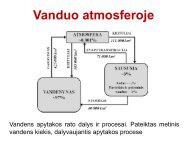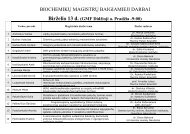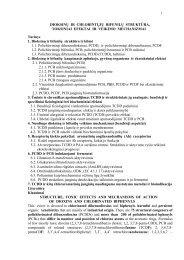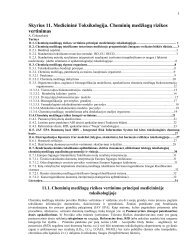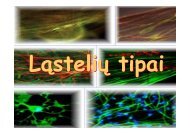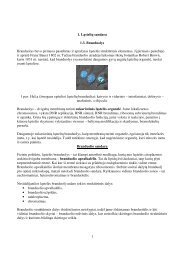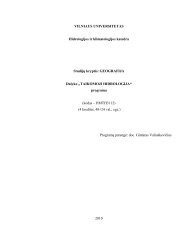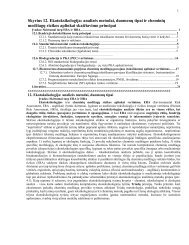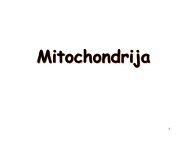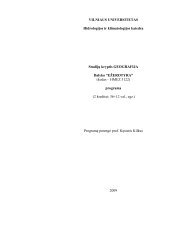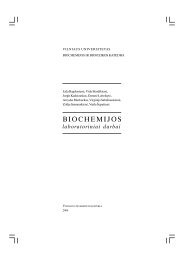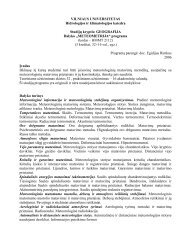Species and Their Formation - Laboratory of Visual Systems
Species and Their Formation - Laboratory of Visual Systems
Species and Their Formation - Laboratory of Visual Systems
Create successful ePaper yourself
Turn your PDF publications into a flip-book with our unique Google optimized e-Paper software.
484 CHAPTER TWENTY-FOURTimeA single species is distributedover a broad range.Sea level rises <strong>and</strong> separates two populations.Populations adapt to differing environmentson opposite sides <strong>of</strong> the barrier.If the barrier is removed, the populationsmay recolonize the intervening area <strong>and</strong>mingle, but do not interbreed.Another example <strong>of</strong> allopatric speciation is found in thefinches <strong>of</strong> the Galápagos archipelago, 1,000 km <strong>of</strong>f thecoast <strong>of</strong> Ecuador. Darwin’s finches (as they are usuallycalled, because Darwin was the first scientist to studythem) arose in the Galápagos by speciation from a singleSouth American species that colonized the isl<strong>and</strong>s. Todaythere are 14 species <strong>of</strong> Darwin’s finches, all <strong>of</strong> which differstrikingly from their closest mainl<strong>and</strong> relative (Figure24.6). The isl<strong>and</strong>s <strong>of</strong> the Galápagos archipelago are sufficientlyisolated from one another that finches seldom dispersebetween them. Also, environmental conditions differamong the isl<strong>and</strong>s. Some are relatively flat <strong>and</strong> arid;others have forested mountain slopes. Populations <strong>of</strong>finches on different isl<strong>and</strong>s have differentiated enoughover millions <strong>of</strong> years that when occasional immigrants arrivefrom other isl<strong>and</strong>s, they either do not breed with theresidents, or, if they do, the resulting <strong>of</strong>fspring usually donot survive as well as those produced by pairs composed<strong>of</strong> isl<strong>and</strong> residents. The genetic distinctness <strong>and</strong> cohesiveness<strong>of</strong> the different species is thus maintained.A physical barrier’s effectiveness at preventing geneflow depends on the size <strong>and</strong> mobility <strong>of</strong> the species inquestion. What is an impenetrable barrier to a terrestrialsnail may be no barrier at all to a butterfly or a bird. Popu-Range <strong>of</strong> overlapNumbers on the isl<strong>and</strong>s representthe number <strong>of</strong> species <strong>of</strong> picturewingedDrosophila found there.Picture-wingedDrosophila24.4 Allopatric Speciation Allopatric speciation may result whena population is divided into two separate populations by a physicalbarrier, such as rising sea levels.only an incomplete representation <strong>of</strong> the gene pool <strong>of</strong> its parentpopulation (see Chapter 23). For example, many <strong>of</strong> themore than 800 species <strong>of</strong> the fruit fly genus Drosophila in theHawaiian Isl<strong>and</strong>s are restricted to a single isl<strong>and</strong>. Thesespecies are almost certainly the descendants <strong>of</strong> new populationsfounded by individuals dispersing among the isl<strong>and</strong>s,because the closest relative <strong>of</strong> a species on one isl<strong>and</strong> is <strong>of</strong>tena species on a neighboring isl<strong>and</strong> rather than a species on thesame isl<strong>and</strong>. Biologists who have studied the chromosomes<strong>of</strong> picture-winged species <strong>of</strong> Drosophila believe that speciationamong this group <strong>of</strong> flies has resulted from at least 45such founder events (Figure 24.5).12Oldestisl<strong>and</strong>Kauai1Oahu29Numbers on the arrows representthe number <strong>of</strong> proposedfounder events. The arrowwidths are proportional tothese numbers.51210<strong>Species</strong> dispersal is primarilyfrom older to younger isl<strong>and</strong>s.73Mauicomplex4015126Youngestisl<strong>and</strong>Hawaii24.5 Founder Events Lead to Allopatric Speciation Thelarge number <strong>of</strong> species <strong>of</strong> picture-winged Drosophila in theHawaiian Isl<strong>and</strong>s is the result <strong>of</strong> founder events: new populationsfounded by individuals dispersing among the isl<strong>and</strong>s.The isl<strong>and</strong>s, which were formed in sequence as Earth’s crust movedover a volcanic “hot spot,” vary in age.



